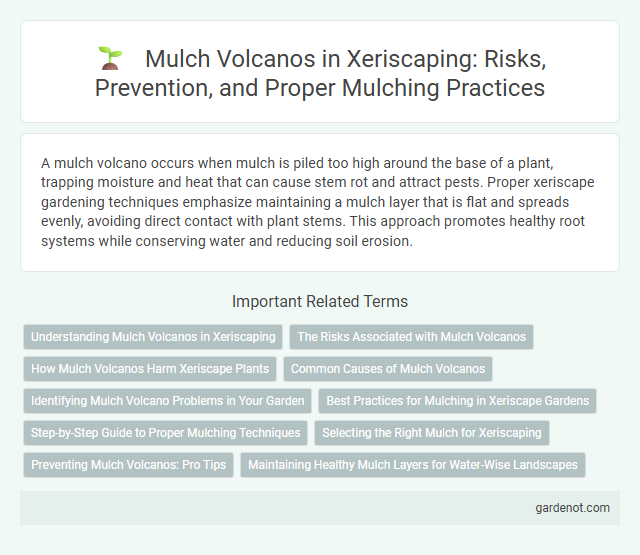A mulch volcano occurs when mulch is piled too high around the base of a plant, trapping moisture and heat that can cause stem rot and attract pests. Proper xeriscape gardening techniques emphasize maintaining a mulch layer that is flat and spreads evenly, avoiding direct contact with plant stems. This approach promotes healthy root systems while conserving water and reducing soil erosion.
Understanding Mulch Volcanos in Xeriscaping
Mulch volcanoes in xeriscaping occur when mulch is piled directly against the base of plants, trapping moisture and causing stem rot or fungal diseases. Proper xeriscape mulch application involves spreading mulch evenly around the root zone without touching the plant stems to improve water retention and soil temperature regulation. Understanding the risks of mulch volcanoes helps maintain plant health and supports efficient water conservation in drought-resistant landscaping.
The Risks Associated with Mulch Volcanos
Mulch volcanos pose significant risks such as trapping moisture against tree trunks, leading to bark decay and increased vulnerability to pests and diseases. Excessive mulch piled around the base can suffocate root systems by restricting oxygen flow, impairing tree health and stability. Proper mulch application should be flat and extend outward, avoiding piled mounds that create hazardous moisture and pest conditions.
How Mulch Volcanos Harm Xeriscape Plants
Mulch volcanos create thick, mounded layers of mulch around plant bases, which traps moisture and encourages bark decay in xeriscape plants adapted to dry conditions. Excessive mulch moisture leads to root rot and fungal diseases, undermining the drought-resistant qualities essential to xeriscaping. Proper mulch application should maintain a flat, even layer to promote aeration and prevent water stagnation that harms xeriscape plant health.
Common Causes of Mulch Volcanos
Mulch volcanoes commonly form due to excessive mulch application around tree bases, often piled up against trunks instead of being spread in a thin, even layer. This improper mulching creates moisture buildup and air deprivation, leading to bark decay and pest infestation. Homeowners and landscapers frequently overlook recommended mulch depth guidelines, resulting in these detrimental mulch volcano formations.
Identifying Mulch Volcano Problems in Your Garden
Mulch volcanoes occur when mulch is piled too high around a plant's base, causing excess moisture retention and creating an environment for rot and pests. Signs of mulch volcano problems include bark decay, root suffocation, and increased susceptibility to fungal infections. Properly identifying and correcting mulch volcano issues helps maintain plant health by improving air circulation and preventing stem girdling.
Best Practices for Mulching in Xeriscape Gardens
Applying mulch in xeriscape gardens requires avoiding the formation of mulch volcanoes, which occur when mulch is piled excessively against plant trunks, leading to moisture retention and potential rot. Best practices include spreading mulch evenly in a 2 to 4-inch layer around the base of plants, leaving space around trunks to allow air circulation and prevent pest infestations. Selecting organic mulches like wood chips or bark not only conserves soil moisture but also improves soil health by gradually decomposing into valuable nutrients in arid landscapes.
Step-by-Step Guide to Proper Mulching Techniques
Create a mulch volcano by applying mulch in a 2 to 4-inch layer around the base of landscape plants, ensuring it extends at least 3 to 4 feet from the trunk. Keep mulch a few inches away from the plant stem to prevent moisture buildup and potential rot. Mulching properly conserves soil moisture, suppresses weeds, and regulates temperature in xeriscape gardens.
Selecting the Right Mulch for Xeriscaping
Selecting the right mulch for xeriscaping involves choosing materials that conserve water, suppress weeds, and regulate soil temperature. Organic mulches like bark, wood chips, or composted leaves improve soil moisture retention while breaking down slowly to enrich the soil. Inorganic options such as gravel or stone are durable, require less maintenance, and facilitate excellent drainage for drought-tolerant plants in xeriscape gardens.
Preventing Mulch Volcanos: Pro Tips
Preventing mulch volcanoes starts with applying a 2 to 3-inch layer of mulch evenly, avoiding piling mulch up against tree trunks to reduce moisture buildup and potential decay. Regularly inspect the base of plants and trees to redistribe mulch and maintain proper airflow, which supports healthy root systems and prevents fungal growth. Utilizing organic mulches like wood chips or bark enhances water retention and soil health while inhibiting weed growth, essential aspects of effective xeriscaping.
Maintaining Healthy Mulch Layers for Water-Wise Landscapes
Maintaining healthy mulch layers in xeriscape gardens is essential for conserving water and promoting plant health by regulating soil moisture and temperature. Avoid creating mulch volcanoes by keeping mulch 2 to 4 inches deep and pulling it away from the base of plants to prevent moisture buildup that can cause root rot. Properly applied mulch reduces irrigation needs, suppresses weeds, and supports efficient water use in drought-tolerant landscapes.
Mulch volcano Infographic

 gardenot.com
gardenot.com